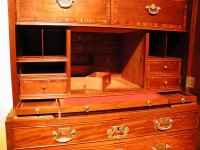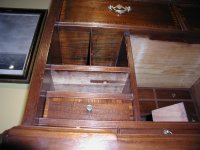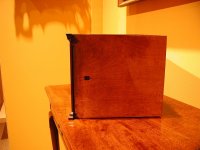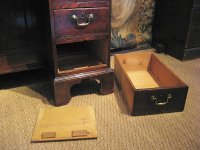I have seen arcaded pigeonholes in a bureau with a few tricks. The arches are often very small drawers that simply pull out, but one I saw actually had to be pushed quite hard which then released the three neighbouring, conjoined arches/drawers. I wasn't able to see the mechanism without removing the backboards.
I have also seen a pigeonhole arch whose front rocked on a central pivot. When one side of the arch was pressed, it forced an integral wedge against a spring catch (part of the actual single-piece drawer) which withdrew it from the side of the pigeonhole allowing the drawer to slide out. The drawer opened to reveal a shallow tray (about 3/16" deep) capable of containing several coins. It was well conceived and made and defeated many people's attempts to discover it's secret.
Document boxes either side of the central door (prospect to you?) often have intriguing catches ranging from tilting the top and pulling the bottom, to pressing or pulling the thin divider beside the box, to sliding the plinth of the attached pilaster etc.
The simple spring catch is used in many situations to secure dummy interiors behind the central doors etc. and is often accessed by first sliding part of the wall, floor or ceiling of the box rearwards to reveal the catch, or a hole through which one inserts a finger to release the catch.





